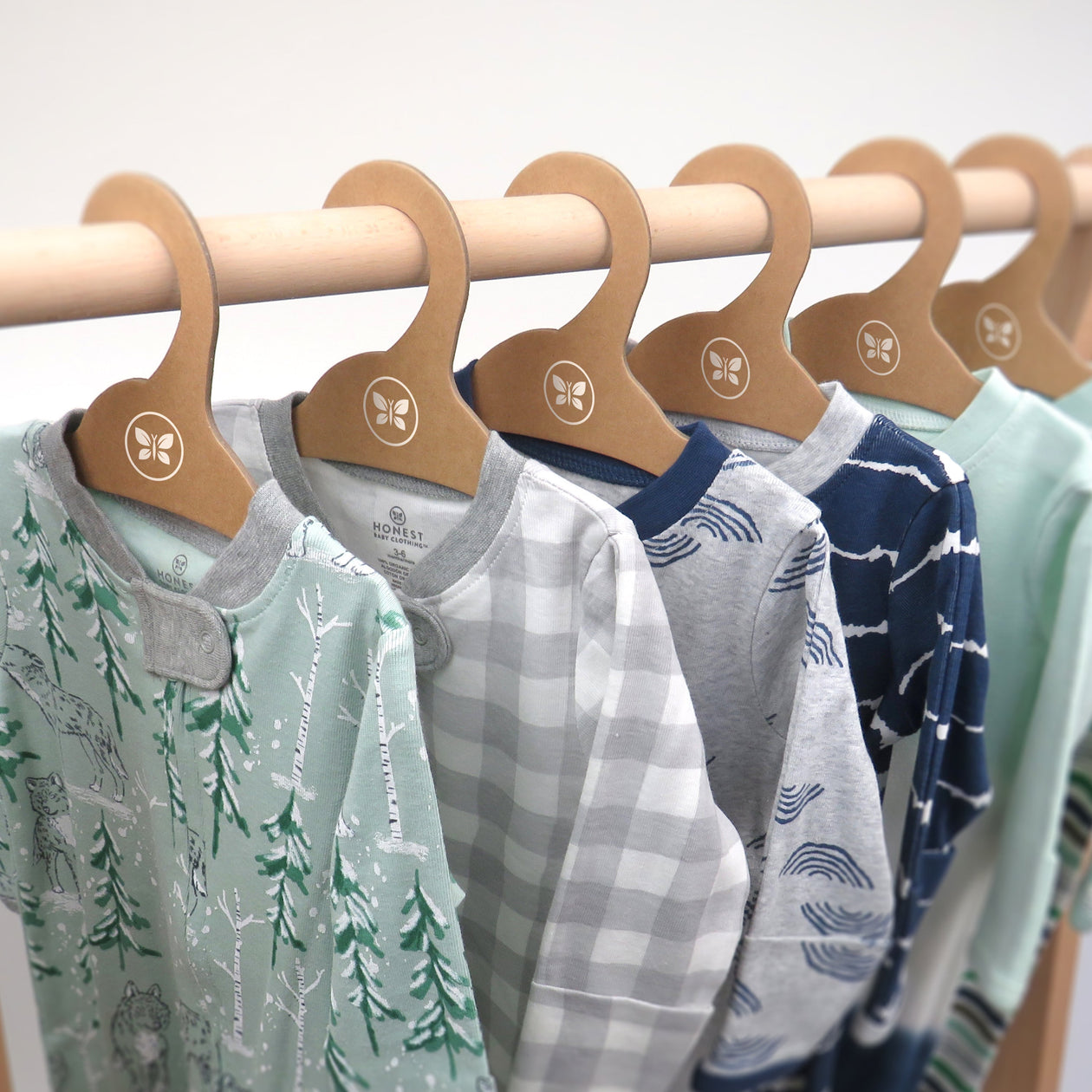
How to Wash and Organize Baby Clothes: A New Parent's Complete Guide
Welcoming a new baby brings endless joy – and endless laundry! Learning how to wash baby clothes properly protects your little one's delicate skin while keeping their organic cotton outfits looking fresh and lasting longer. Whether you're dealing with your first load of newborn clothes or organizing a growing wardrobe, this guide will help you master both washing and organizing your baby's clothes with confidence.
Pre-Washing Preparation: Setting Up for Success
Always start by checking the care label – this is your most important first step before washing any baby's clothing. The care label tells you everything you need to know about water temperature, cycle settings, and special instructions for delicate fabrics.
Start by sorting baby clothes into separate piles. Group items by color (lights, darks, and whites), fabric type (organic cotton, delicate fabrics, and regular materials), and soil level. New clothes should always be washed before your baby wears them to remove any manufacturing residues that might cause skin irritation.
For stubborn stains – and trust us, there will be many – treat them as soon as possible. Gently rinse with cold water and apply a small amount of gentle detergent directly to the stain. Let it sit for a few minutes before washing. This pre-treatment works wonders on everything from spit-up to diaper blowouts.
Keep newborn clothes separate from older children's clothing, especially during those first few months when your baby's sensitive skin is most vulnerable to harsh chemicals or allergens.
How to Wash Baby Clothes: Step-by-Step Guide
Important: Always Check the Care Label First
Before following any washing steps, read the care label on each garment. This tag provides essential information about water temperature, cycle settings, and any special care requirements specific to that item.

Step 1: Choose the Right Detergent
Skip regular detergent and fabric softener for baby's clothes. Instead, use a gentle detergent specifically designed for sensitive skin or a baby detergent that's free from harsh chemicals, dyes, and fragrances.
Step 2: Set Your Washing Machine Correctly
Use the gentle cycle for most baby clothes, especially delicate fabrics and newborn's clothes. Cold water works perfectly for most loads and helps prevent shrinking of organic cotton items. For heavily soiled items or cloth diapers, warm water at a higher temperature may be necessary, but check the care label first.
Step 3: Load the Machine Properly
Don't overcrowd your washing machine. Baby clothes need room to move around and get properly cleaned. A good rule of thumb: fill the machine only two-thirds full for the best results.
Step 4: Skip the Fabric Softener
While fabric softener might seem like a good idea, it can actually irritate your baby's skin and reduce the absorbency of organic cotton. Your baby's clothing will naturally become softer with each wash, especially organic cotton items.
Step 5: Double Rinse When Needed
If you're concerned about detergent residue, run an extra rinse cycle. This is especially important for newborn baby clothes, or if your little one has particularly delicate skin.
Drying and Care Best Practices
-
Air drying is the gentlest option for baby's clothing and helps prevent shrinking, especially with organic cotton garments. Hang items in a well-ventilated area away from direct sunlight, which can fade colors and weaken fibers.
-
If you must use the dryer, choose a low heat setting and remove clothes while they're slightly damp to prevent over-drying. Skip dryer sheets completely – they contain chemicals that can irritate your baby's sensitive skin and leave residues on the fabric.
-
For organic cotton items, air drying helps maintain the fabric's natural softness and extends the life of the garment. Plus, you'll avoid the risk of shrinking that can happen at the highest temperature settings in the dryer.
-
Consider investing in a drying rack specifically for baby clothes. The smaller size makes it perfect for tiny socks, onesies, and delicate items that need extra care.
Smart Organization Systems for Baby Wardrobes
-
Start with size sorting: Create separate sections for current size, next size up, and clothes to donate or store.
-
Use drawer dividers: Separate onesies, sleepers, pants, and socks to make middle-of-the-night diaper changes easier.
-
Implement a rotation system: Keep current-size clothes accessible, store next size up separately, and pack away outgrown items immediately.
-
Organize cloth diapers: Create dedicated storage for clean and dirty reusable nappies with easy access for wash day.
-
Label everything: Use simple labels like "3-6 months" or "summer clothes" for quick identification by all caregivers.
-
Create seasonal storage: Pack away out-of-season clothes in labeled bins to keep your baby's immediate wardrobe manageable.
Your Journey to Stress-Free Baby Laundry
Washing and organizing baby clothes doesn't have to be overwhelming. By following these simple steps – always checking care labels first, using gentle detergent, choosing appropriate water temperatures, and creating smart organization systems – you'll keep your baby's clothing clean, soft, and ready for all their adventures.
Remember that protecting your baby's skin is the top priority. Avoid harsh chemicals, fabric softeners, and high temperatures that can cause irritation. With proper care, your baby's organic cotton clothes will stay comfortable and beautiful through countless wears and washes.
Start with these basics, and you'll quickly develop a routine that works for your family. Before long, doing baby laundry will become second nature, leaving you more time to enjoy those precious moments with your little one.


